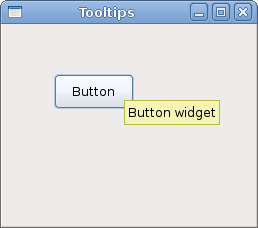First steps in PyGTK
In this part of the PyGTK programming tutorial, we will do our first steps in programming. We will create simple programs.Simple example
The first code example is a very simple one.center.py
#!/usr/bin/pythonThis code shows a centered window.
# ZetCode PyGTK tutorial
#
# This is a trivial PyGTK example
#
# author: jan bodnar
# website: zetcode.com
# last edited: February 2009
import gtk
class PyApp(gtk.Window):
def __init__(self):
super(PyApp, self).__init__()
self.connect("destroy", gtk.main_quit)
self.set_size_request(250, 150)
self.set_position(gtk.WIN_POS_CENTER)
self.show()
PyApp()
gtk.main()
import gtkWe import the gtk module. Here we have objects to create GUI applications.
class PyApp(gtk.Window):Our application is based on the PyApp class. It inherits from the Window.
def __init__(self):This is the constructor. It builds our application. It also calls it's parent constructor through the super() call.
super(PyApp, self).__init__()
self.connect("destroy", gtk.main_quit)
We connect the destroy signal to the main_quit() function. The destroy signal is called when we click on the close button in the titlebar or press Alt + F4. The window is being destroyed, but the application is not. You can see it, if you launch the example from the command line. By calling the main_quit() we quit the application for good. self.set_size_request(250, 150)We set the size of the window to 250x150px.
self.set_position(gtk.WIN_POS_CENTER)This line centers the window on the screen.
self.show()Now we show the window. The window is not visible, until we call the show() method.
PyApp()We create the instance of our program and start the main loop.
gtk.main()
Icon
In the next example, we show the application icon. Most window managers display the icon in the left corner of the titlebar and also on the taskbar.icon.py
#!/usr/bin/pythonThe code example shows the application icon.
# ZetCode PyGTK tutorial
#
# This example shows an icon
# in the titlebar of the window
#
# author: jan bodnar
# website: zetcode.com
# last edited: February 2009
import gtk, sys
class PyApp(gtk.Window):
def __init__(self):
super(PyApp, self).__init__()
self.set_title("Icon")
self.set_size_request(250, 150)
self.set_position(gtk.WIN_POS_CENTER)
try:
self.set_icon_from_file("web.png")
except Exception, e:
print e.message
sys.exit(1)
self.connect("destroy", gtk.main_quit)
self.show()
PyApp()
gtk.main()
self.set_title("Icon")
We set a title for the window. self.set_icon_from_file("web.png")
The set_icon_from_file() method sets an icon for the window. The image is loaded from disk in the current working directory. Figure: Icon
Buttons
In the next example, we will further enhance our programming skills with the PyGTK library.buttons.py
#!/usr/bin/pythonWe show four different buttons on the window. We will see a difference between container widgets and child widgets and will change some properties of child widgets.
# ZetCode PyGTK tutorial
#
# This example shows four buttons
# in various modes
#
# author: jan bodnar
# website: zetcode.com
# last edited: February 2009
import gtk
class PyApp(gtk.Window):
def __init__(self):
super(PyApp, self).__init__()
self.set_title("Buttons")
self.set_size_request(250, 200)
self.set_position(gtk.WIN_POS_CENTER)
btn1 = gtk.Button("Button")
btn1.set_sensitive(False)
btn2 = gtk.Button("Button")
btn3 = gtk.Button(stock=gtk.STOCK_CLOSE)
btn4 = gtk.Button("Button")
btn4.set_size_request(80, 40)
fixed = gtk.Fixed()
fixed.put(btn1, 20, 30)
fixed.put(btn2, 100, 30)
fixed.put(btn3, 20, 80)
fixed.put(btn4, 100, 80)
self.connect("destroy", gtk.main_quit)
self.add(fixed)
self.show_all()
PyApp()
gtk.main()
btn1 = gtk.Button("Button")
A Button is a child widget. Child widgets are placed inside containers. btn1.set_sensitive(False)We make this button insensitive. This means, we cannot click on it. Nor it can be selected, focused etc. Graphically the widget is grayed out.
btn3 = gtk.Button(stock=gtk.STOCK_CLOSE)The third button shows an image inside it's area. The PyGTK library has a built-in stock of images, that we can use.
btn4.set_size_request(80, 40)Here we change the size of the button.
fixed = gtk.Fixed()Fixed widget is a non visible container widget. It's purpose is to contain other child widgets.
fixed.put(btn1, 20, 30)Here we place button widgets inside fixed container widget.
fixed.put(btn2, 100, 30)
...
self.add(fixed)We set the Fixed container to be the main container for our Window widget.
self.show_all()We can either call show_all() method, or we call show()method on each of the widgets. Including containers.

Figure: Buttons
Tooltip
A tooltip is a hint on a widget in the applications. Can be used to provide additional help.tooltips.py
#!/usr/bin/pythonIn this example we set a tooltip for a window and for a button.
# ZetCode PyGTK tutorial
#
# This code shows a tooltip on
# a window and a button
#
# author: jan bodnar
# website: zetcode.com
# last edited: February 2009
import gtk
class PyApp(gtk.Window):
def __init__(self):
super(PyApp, self).__init__()
self.set_title("Tooltips")
self.set_size_request(250, 200)
self.set_position(gtk.WIN_POS_CENTER)
self.connect("destroy", gtk.main_quit)
self.fixed = gtk.Fixed()
self.add(self.fixed)
button = gtk.Button("Button")
button.set_size_request(80, 35)
self.fixed.put(button, 50, 50)
self.set_tooltip_text("Window widget")
button.set_tooltip_text("Button widget")
self.show_all()
PyApp()
gtk.main()
self.set_tooltip_text("Window widget")
button.set_tooltip_text("Button widget")
The set_tooltip_text() does the job. 
Figure: Tooltips
In this chapter, we created first programs in PyGTK programming library.
No comments:
Post a Comment